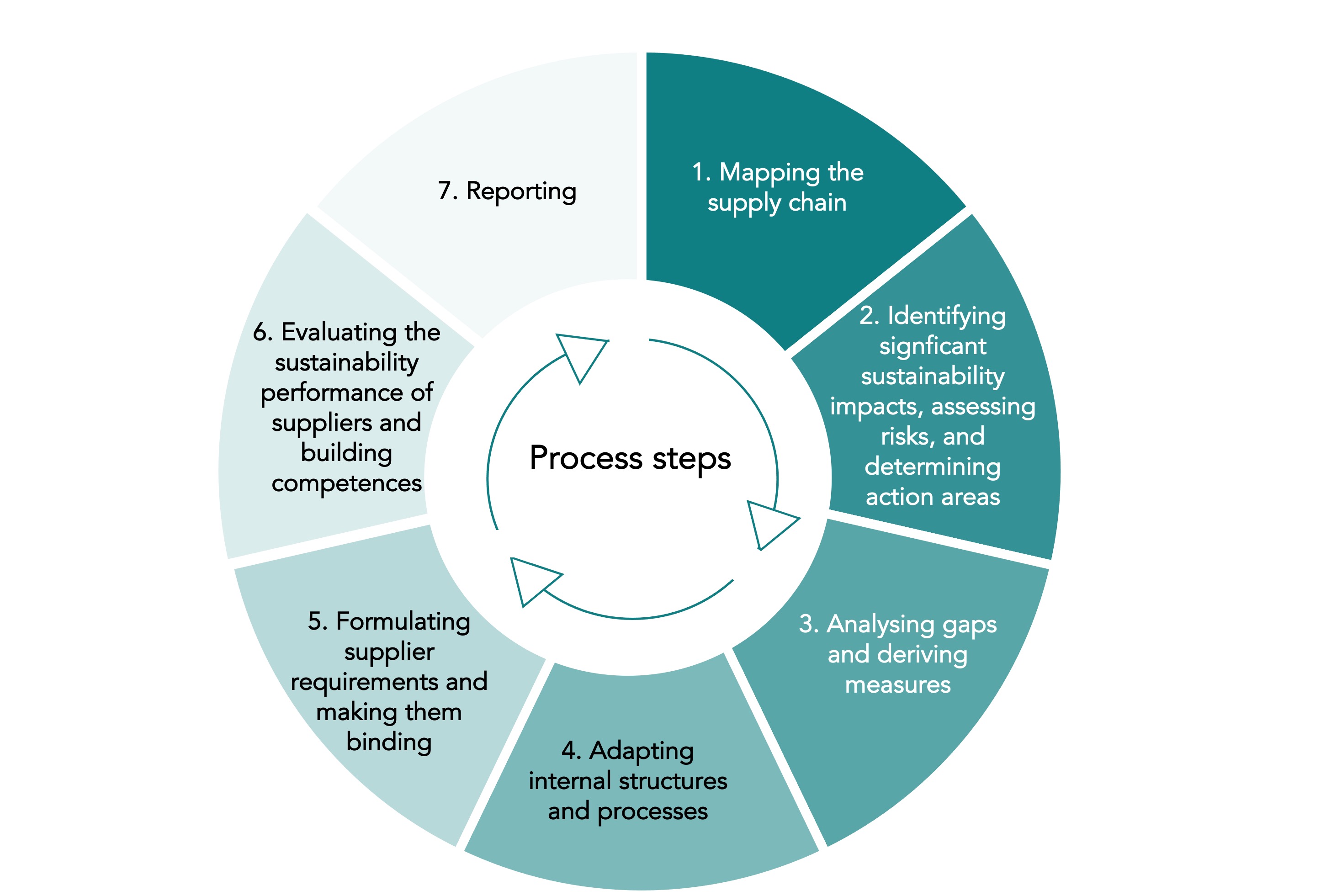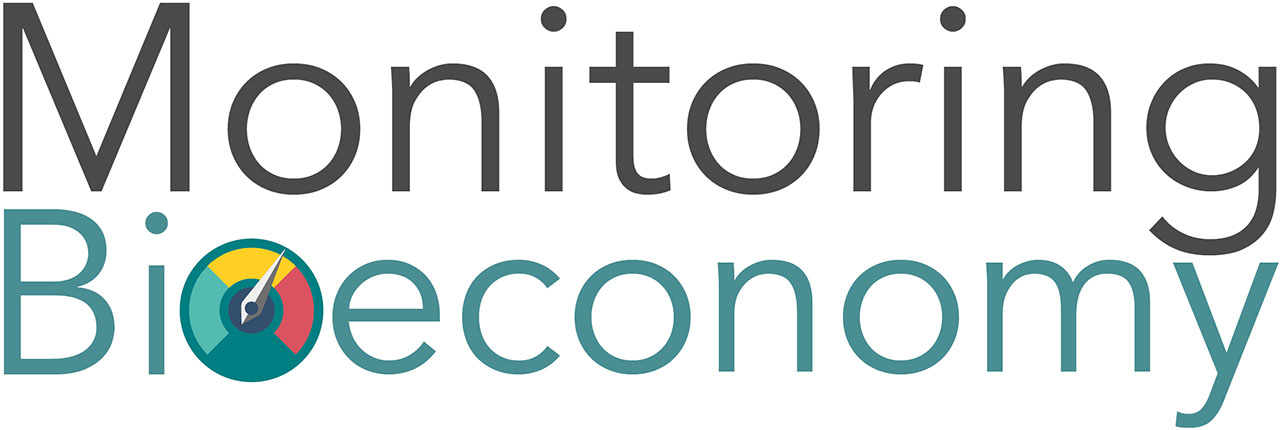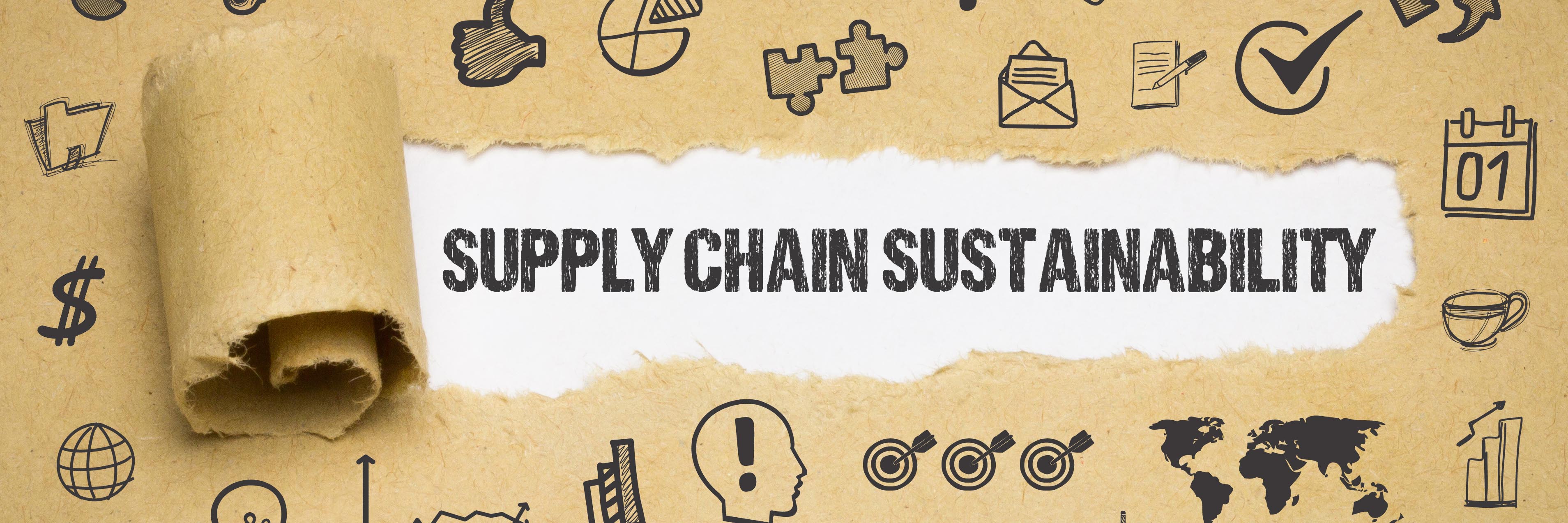What is sustainable supply chain management and certification? I What is certification? I How are supply chain management and certification used to contribute to a sustainable bioeconomy? I What are the limitations? I Limitations and challenges related to certification
What is sustainable supply chain management and certification?
The goal of sustainable supply chain management is to reduce, eliminate and manage the impacts and risks of production at their place of origin and across the supply chain (both upstream and downstream). In particular social and environmental criteria need to be fulfilled, as well as company competitiveness maintained [1]. Social responsibility — e.g. as mandated in Germany by the Supply Chain Act, which aims to ensure that human rights are respected—is a major objective, as well as increasing transparency. For example, businesses report on environmental performance within a variety of reporting schemes (e.g. EMAS [3] and ISO 14001 [4]), and multiple guides and tools are available for strengthening company performance [5]. The figure below depicts seven process steps of sustainable supply chain management [6].

Seven process steps of sustainable supply chain management (Source: BMUB and UBA (2017) [6], pp. 6)
What is certification?
Certification and standards provide customers with information on whether the production of a product has met specific norms related to social, environmental and/or economic criteria, in particular at the beginning of the supply chain. In addition, companies use certification to manage and minimize risks in the supply chain and to maintain their license to operate. Certification and standards are typically adopted voluntarily and combined with compliance verification [7], traceability systems [8], and labels to distinguish products in the marketplace. They may be applied in a business-to-business context (e.g. Global G.A.P. [9]) or directed at the final consumer (e.g. Fairtrade [10]) or both (e.g. ISCC PLUS [11]). Certification schemes also increasingly play a role in regulated markets where they are used to independently verify compliance with sustainability requirements. Examples include the Renewable Energy Directive (RED) under which the European Commission has recognized certification schemes [12] or CORSIA (Carbon Offsetting and Reduction Scheme for International Aviation), a system established by ICAO (International Civil Aviation Organization, a UN Agency [13]. There has been a proliferation of environmental standards (see e.g. the Standards map) and labels (see e.g. the Ecolabel Index) linked to varying degrees of strength [14] (which can be evaluated by consumers on e.g. Label online).
How are supply chain management and certification used to contribute to a sustainable bioeconomy?
Around one-quarter to half of the environmental impacts from consumption are felt in regions other than where that consumption occurs [15]. For instance, 30% of global species threats [16] and 32% of the consumption of scarce water [17] have been linked with international trade. Between 2005 and 2013 more than 60% of forest loss could be attributed to the expanding area of commercial cropland, pastures and tree plantations, in particular for cattle meat, forestry products, oil palm, cereals and soybeans [18]. Preventing global forest loss, connected to the biodiversity and climate crises, is one of the core challenges of implementing a sustainable bioeconomy. To this end, restrictions on “land use change” are starting to be incorporated into standards, norms and legislation [19] in a more stringent way [20]. This is one manner in which reporting and certification have an essential role to play to ensure that the bioeconomy is supplied by sustainably-produced biomass.
Overall, they act to connect (link through monitoring and awareness raising) and help prevent (through the establishment of best practice norms) the impacts of local production abroad. Some environmental and social impacts are well established elements of reporting and certification (e.g. banning child labour and avoiding toxic substances) whereas others are more in their infancy (e.g. biodiversity—see the Biodiversity in Good Company Initiative) [21].
What are the limitations?
The basic limitation of product chain-based measures is that a growing demand for products which may be locally produced in a sustainable fashion may result in unsustainable effects at larger scales. One prominent example is the indirect land use change induced by a growing use of 1st generation biofuels, which cannot be solved even by the updated certification criteria required by the EU Commission (RED II). If, theoretically, all agriculture would work organically worldwide, the criteria of local sustainability would be fullfilled, however, the global agricultural area would need to expand to compensate for up to one-third lower yields [22], leading to biodiversity losses etc., if no countermeasures such as changed dietary patterns and/or reduced food loss generation would be applied.
Limitations and challenges related to certification
There is currently a spatial scale mismatch between a) the farm, farm cluster or plantation that is certified and b) the scale at which desired benefits are delivered [23]. This can limit benefits at a landscape scale (e.g. biological connectivity, watershed functions, and other ecosystem services) and may lead to ineffectiveness to e.g. combat deforestation at the scale needed. That said, the current collection of studies covering the effectiveness of sustainability certification is scarce and existing studies point in different directions [24]. Moreover, investments and activities to mitigate risks and improve stringency, quality and effectiveness are widespread. Those risks include loopholes and corruption (e.g. using subsidiary companies and partial certification). Some have also pointed to a risk of “washing down” in some cases [25] – e.g. decreasing stringency in order to raise market uptake for certification. Among customers a growing body of labels could also lead to difficulty to distinguish between them, which carries the risk of a loss of faith in the standards process by customers (e.g. accusations of greenwashing), but which other studies also dispute [26]. Progress in the opposite direction is also clearly visible. For example, some certification schemes are already working on the integration of landscape/jurisdictional approaches [27], on the use of remote sensing data [28] on improving biodiversity at a landscape level [29], and on setting minimum standards. Recommendations and possibilities are promising (e.g. for the food sector see the Business & Biodiversity campaign).
However, there are also some inherent gaps from a monitoring perspective linked to the nature and purpose of certification, which is why a bundle of approaches is so important. For example, standards focus on production practices, but do not measure the outputs or impacts of changed practices on the environment. Auditors can and should be trained to incorporate aspects related to biodiversity into verification systems (like ‘potential for biodiversity created’ [21]), but additional monitoring is needed to understand the greater system-wide impacts of change (at ecosystem, landscape, ecoregion and biosphere levels). This is why complementary action is needed—in terms of monitoring and regulation (both in the countries of origin and consuming countries — see Footprints).
Many of the same issues also limit sustainable supply chain management and reporting, especially in terms of effectiveness — at least currently. For example, reporting is often focused on providing transparency and applying best practices, but not on the detailed measurement and monitoring of impacts across scales. Biodiversity has also been — up to now —widely neglected and/or vague in accountability and reporting schemes [30]. However, social and environmental certification schemes have started their own regular impact assessments, based to a large extent on ISEAL’s Code of Good Practice [31], which is also leading to improvements of the systems [2]. In addition, a multitude of efforts are underway to close this gap, also driven by the interests of companies themselves to be agents of change (see e.g. the EU Business @ Biodiversity Platform). The need and potentials to ensure a safe, secure and sustainable supply of biomass for the bioeconomy are both pressing and vast, and depends on how quickly and comprehensively businesses are willing to invest in ensuring that their supply chains are, indeed, sustainable.
Notes and references
- Seuring and Müller (2008). From a literature review to a conceptual framework for sustainable supply chain management. Journ. of Cleaner Product. doi: 10.1016/j.jclepro.2008.04.020.
- See impact reports of different certification schemes: ISCC (2022). Available at: https://www.iscc-system.org/wp-content/uploads/2022/06/ISCC-Impact-Report-2022.pdf
RSB (2021). Available at: https://rsb.org/wp-content/uploads/2022/09/RSB-Impact-Report-2021.pdf
Rainforest Alliance (2019). Available at: https://issuu.com/rainforest-alliance/docs/rainforest-alliance_impacts_report_2019_singles - The EU Eco-Management and Audit Scheme (EMAS) is used by companies and organisations to evaluate, report and improve their environmental performance. Available at: https://ec.europa.eu/environment/emas/
- ISO14001 is an environmental management system. Available at: https://www.iso.org/iso-14001-environmental-management.html.
- See for example the Global Reporting Initiative. Available at: https://www.globalreporting.org.
- BMUB and UBA (2017). Step-by-Step Guide to Sustainable Supply Chain Management: A Practical Guide for Companies. Available at: https://www.bmuv.de/fileadmin/Daten_BMU/Pools/Broschueren/nachhaltige_lieferkette_en_bf.pdf.
- Characteristic of verification is that auditors assess social and environmental practices and/or performance through on-site inspection, interviews, farm records, and other corroborating information.
- Traceability systems (chain-of-custody) track certified products from origin to point-of-sale.
- Global G.A.P. (good agricultural practices) is a global trademark and set of standards for the certification of agricultural products with the objective of safe, sustainable agriculture worldwide. More information is available at: https://www.globalgap.org
- Fairtrade Standards are designed to support the sustainable development of small producer organizations and agricultural workers in developing countries. Over 1.7 million farmers and workers were involved in Fairtrade in 72 producing countries, with more than 35,000 products available to shoppers sold in 145 different countries in 2019. More information is available at: https://www.fairtrade.net
- International Sustainability and Carbon Certification (ISCC) is a global, third-party, multi-stakeholder sustainability certification system, covering biogenic and circular raw materials and respective value chains. More information is available at: https://www.iscc-system.org
- The RED (2009/28/EC) and the RED II (Directive (EU) 2018/2001) inter alia regulate the use of renewable energy in the transport sector in the EU. To verify sustainability of biofuels at cultivation level, the greenhouse gas emissions and traceability, the European Commission has recognized several sustainability certification schemes for the production of sustainable biofuels, bioliquids and biomass fuels. More information is available at: https://energy.ec.europa.eu/topics/renewable-energy/bioenergy/voluntary-schemes_en
- In 2016, 191 ICAO Member States agreed on a global instrument for climate protection for the international aviation sector that shall lead to a CO2 neutral growth. A key instrument to achieve the CO2 targets is the use of "renewable" jetfuels. Sustainability and CO2 savings of these fuels will be controlled by recognized certification schemes. More information is available online: https://www.icao.int/environmental-protection/CORSIA/Pages/CORSIA-SCS-evaluation.aspx.
- See for example the State of Sustainability Initiatives. Available at: https://www.iisd.org/ssi/
- This includes e.g. carbon emissions, chemical pollutants, biodiversity loss, and the depletion of freshwater resources, amoung others. See IPBES (2018). Summary for policymakers of the thematic assessment report on land degradation and restoration of the Intergovernmental Science-Policy Platform on Biodiversity and Ecosystem Services. Available at: https://ipbes.net/assessment-reports/ldr.
- Lenzen et al. (2012). International trade drives biodiversity threats in developing nations. doi: 10.1038/nature11145.
- Lenzen et al. (2013). International trade of scarce water. Ecologic. Econom. doi: 10.1016/j.ecolecon.2013.06.018.
- Pendrill et al. (2019). Agricultural and forestry trade drives large share of tropical deforestation emissions. Glob. Environ. Chang. doi: 10.1016/j.gloenvcha.2019.03.002.
- In 2009, the RED already ruled out the conversion of high carbon stock and high biodiverse areas. Under the RED certification schemes were recognized to monitor the direct land use change accordingly. There is additional EU legislation in this space, e.g. a regulation on deforestation-free products is foreseen. Available at: https://environment.ec.europa.eu/publications/proposal-regulation-deforestation-free-products_en
- GNF and LCF (2017a). Baseline report. Biodiversity in Standards and Labels for the Food Sector. Available at: https://www.business-biodiversity.eu/en/baseline-report <<Accessed: January 19, 2023>>
- Beck-O’Brien and Bringezu (2021). Biodiversity Monitoring in Long-Distance Food Supply Chains: Tools, Gaps and Needs to Meet Business Requirements and Sustainability Goals. doi: 10.3390/su13158536.
- Yield differences are highly contextual and the variation is substantial. Seufert et al. (2012) found that yield differences range from 5 to 34% lower organic yields (Seufert et al. (2012). Comparing the yields of organic and conventional agriculture. Nat. doi: 10.1038/nature11069). Ponti et al. (2012) conclude that organic yields of individual crops are 20% lower than conventional farming (Ponti et al. (2012). The crop yield gap between organic and conventional agriculture. Agricult. Syst. doi: 10.1016/j.agsy.2011.12.004.). See also Crops and livestock about organic farming and Food and feed for alternatives to reduce resource needs on the consumption side. Tscharntke et al. (2015). Conserving biodiversity through certification of tropical agroforestry crops at local and landscape scales. doi: 10.1111/conl.12110.
- van der Ven (2018). Do eco-labels prevent deforestation? Lessons from non-state market driven governance in the soy, palm oil, and cocoa sectors. Glob. Environ. Chang. doi: 10.1016/j.gloenvcha.2018.07.002.
Marx et al. (2022). Voluntary Sustainability Standards: State of the Art and Future Research. doi: 10.3390/standards2010002. - Bray (2019). Institutional environments and the livelihood impacts of voluntary sustainability standards: A Village-based analysis from southern Sumatra's coffee sector. doi: 10.1111/sjtg.12275.
- Jellema et al. (2022). Questioning Impact: A Cross-Disciplinary Review of Certification Standards for Sustainability. doi: 10.1177/00076503211056332.
- For example, there is evidence of ‘Forum shopping' in the Indonesian palm oil sector, where some producers support the less stringent Indonesian Sustainable Palm Oil (ISPO) instead of the more demanding RSPO certification; Anderson et al. (2016). Green growth rhetoric versus reality: insights from Indonesia. Glob. Environ. Chang. doi: 10.1016/j.gloenvcha.2016.02.008
- See for example ISCC on landscape approach. Available at: https://www.iscc-system.org/independent-smallholder/iscc-landscape-approach/.
Or RSPO on jurisdictional approach. Available at: https://rspo.org/resources/certification/jurisdictional-approach - See for example ISCC on the use of remote risk assessments and remote sensing data. Available at: https://www.iscc-system.org/introduction-of-the-aria-platform/.
- 4C as a major coffee sustainability certification system is for example working on improving biodiversity in coffee landscapes in Vietnam. Available at: https://www.4c-services.org/about/project-portfolio/improving-biodiversity-in-coffee-landscapes-in-vietnam/.
- See also: Addison et al. (2018). Using conservation science to advance corporate biodiversity accountability. Biol. doi: 10.1111/cobi.13190. as well as Addison et al. (2018b). The development and use of biodiversity indicators in business: an overview. Available at: https://catalogue.unccd.int/1043_2018-049-En.pdf <<Accessed January 19, 2023>>
- International Social and Environmental Accreditation and Labelling Alliance – ISEAL (2014). Assessing the Impacts of Social and Environmental Standards Systems – ISEAL Code of Good Practice. Available at: https://www.isealalliance.org/defining-credible-practice/iseal-codes-good-practice <<Accessed January 19, 2022>>.



